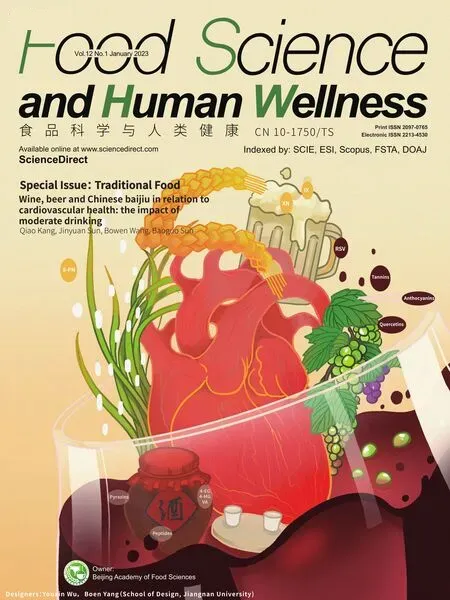Analysis of the changes of volatile f lavor compounds in a traditional Chinese shrimp paste during fermentation based on electronic nose,SPME-GC-MS and HS-GC-IMS
2023-01-22YingLiLiYunHuijieLiuHongyingLiuYueZhouMionnLiRuichngGo
Ying Li, Li Yun, Huijie Liu, Hongying Liu, Yue Zhou, Mionn Li, Ruichng Go,*
a School of Food and Biological Engineering, Jiangsu University, Zhenjiang 212013, China
b Ocean College, Hebei Agriculture University, Qinhuangdao 066000, China
Keywords:Traditional Chinese shrimp paste Electronic nose SPME-GC-MS HS-GC-IMS ROAV
A B S T R A C T Traditionally fermented shrimp paste has a long fermentation period and is susceptible of external factors,which leads to unstable quality and limits its development and application. Therefore, the purpose of this study is to analyze the f lavor changes in the shrimp paste fermentation process and screen out the key volatile aroma components in the shrimp paste to control the f lavor quality of the shrimp paste products. The overall odor prof ile was detected by the electronic nose. A total of 106 volatile f lavor compounds in the shrimp paste samples at different fermentation stages were identif ied by solid-phase microextraction-gas chromatographymass spectrometry (SPME-GC-MS) and headspace-gas chromatography-ion mobility spectrometry (HS-GCIMS). The main aroma components alcohols, aldehydes, pyrazines and other substances in the fermentation process showed an overall upward trend. A total of 17 key volatile aroma components in shrimp paste at different fermentation stages were identified by the relative aroma activity value (ROAV) method. The combination of electronic nose, SPME-GC-MS and HS-GC-IMS could comprehensively ref lect the changes of volatile components in shrimp paste at different fermentation stages, which helps to further understand the mechanism of shrimp paste f lavor formation and provides a basis for the regulation of the f lavor quality of shrimp paste products.
1. Introduction
Shrimp paste is a traditional fermented condiment in China,Malaysia, Singapore, Thailand and other Southeast Asian regions,which is made from low-value shrimps added with salt, ground into a viscous shape and fermented [1]. Shrimp paste is rich in protein,calcium, iron, selenium, vitamin A and other nutrients [2]. There is also a very important antioxidant nutrient in shrimp paste-astaxanthin,and moderate consumption is quite beneficial to the body. Shrimp paste is a kind of fermented food, during the fermentation, protein will be broken down into amino acids and fat will be converted into fatty acids, thus producing a unique and delicious f lavor [3]. However,Chinese usually use natural fermentation to produce shrimp paste, the whole process is very long and is very susceptible to uncontrollable factors such as seasons, weather, and temperature, resulting in unstable product quality especially in f lavor.
In addition, the current research on the flavor of fermented food mainly focused on the finished product, and there were few reports on the changes of flavor during the fermentation process of shrimp paste [4-6]. The f lavor formation process of shrimp paste is quite complicated. To obtain a stable flavor quality and effectively control the fermentation process, it is urgent to analyze the flavor formation mechanism during the fermentation process of shrimppaste. Therefore, the purpose of this study is to analyze the flavor changes during the fermentation of shrimp paste, which provides the possibility to regulate the flavor quality during the fermentation of shrimp paste.

Table 1 Shrimp paste fermentation conditions in different months.
At present, a variety of detection technologies have been widely used in the research of food’s volatile flavor. Electronic nose (E-nose)is an aroma detection technology, which can quickly, sensitively and non-destructively distinguish sample, but cannot accurately analyze the volatile flavor components in sample [7,8]. Solid phase microextraction (SPME), gas chromatography (GC), and mass spectrometry (MS) are combined to determine the relative molecular mass. This method has the characteristics of high sensitivity on the determination of high molecule weight substance [9,10]. But there are limitations in the determination of low molecular weight substances and trace substances. Headspace-gas chromatography-ion mobility spectrometry (HS-GC-IMS) can improve the accuracy and sensitivity of flavor detection, and effectively solve the problems of the slow speed of GC-MS analysis and loss of aroma substances due to preprocessing [11,12]. However, the limitations of its database hinders its qualitative determination of volatile compounds. In recent years, GCIMS has been widely used in many fields such as food flavor analysis and quality inspection [13,14]. The combination of SPME-GC-MS and E-nose technology is conducive to the comprehensive study of food flavor from the macro and micro level, which is currently the main method for detecting food volatile flavor substances [15].However, few studies combine the three detection methods to analyze the flavor of shrimp paste. In this study, the E-nose, SPME-GC-MS and HS-GC-IMS three detection methods were combined to analyze the changes of volatile flavor compounds during the fermentation.Also, the method of calculating the relative aroma activity value(ROAV) was used to screen the key volatile flavor compounds in the fermentation process of shrimp paste. This work provided a basis for analyzing the formation path and mechanism of traditional shrimp paste volatile flavor, and provides a theoretical basis for the regulation of the flavor quality of shrimp paste products.
2. Material and methods
2.1 Sample collection
All shrimp paste samples that fermented using the traditional method are taken from a Cangzhou Shrimp Paste Factory, Hebei province, China. The production time of the samples was from October 2019 to June 2020. The fermentation conditions are shown in Table 1. Therefore, samples (300 g) from seven fermentation stages named m0-m8 (0, 1, 4, 5, 6, 7, 8 months) were selected for the E-nose,SPME-GC-MS and HS-GC-IMS analysis.
2.2 E-nose analysis
The E-nose system (PEN3, Air sense Analytics GmbH, Germany)was used to detect the volatile compounds of the shrimp paste according to the method of Shi et al. [16] with some modifications,The system contained 10 metal oxide sensors as shown in Table 2.Briefly, accurately 1.0 g of the shrimp paste samples at different fermentation stages were placed into a 20 mL vial, immediately sealed with a PTFE-coated cap, then equilibrated at room temperature for 2 h. Before the sample detection, the air washing time was selected as 200 s, the E-nose probe was inserted for measurement,and the measurement lasted 120 s. All samples were run with three repetitions.
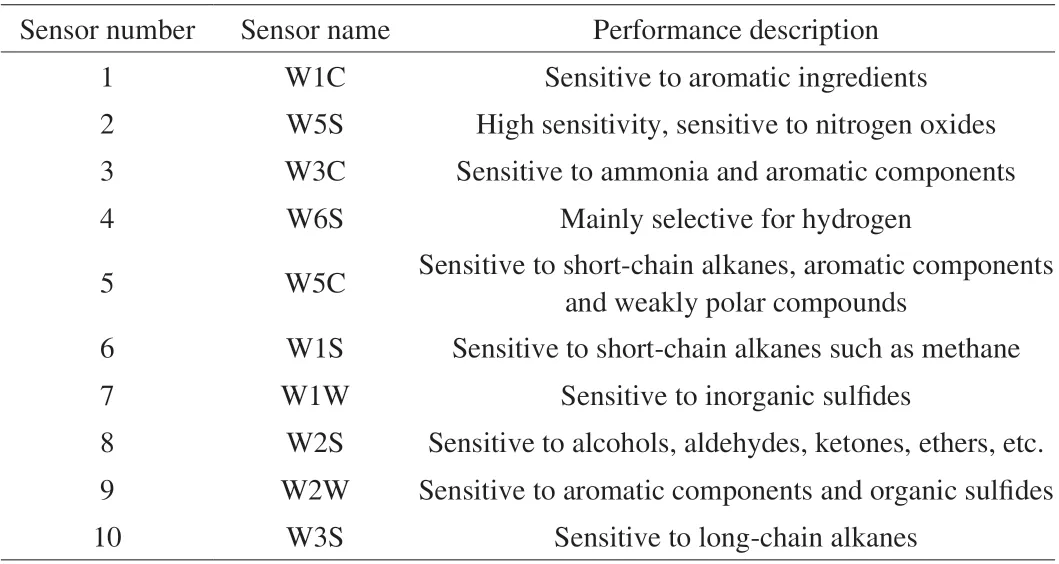
Table 2 Sensor sensitivities within the sensor array of the PEN3 E-nose.
2.3 SPME-GC-MS analysis
2.3.1 Extraction of volatile compounds
Volatile compounds were detected by solid-phase microextraction gas chromatography-mass spectrometry according to the method of Yang et al. [17] with some modifications. Briefly, shrimp paste samples (1.0 g) were put into a 20 mL headspace vial and immediately sealed with a tetrafluoroethylene rubber cushion cap.The vial was equilibrated at 45 °C for 5 min, and the preconditioned(activated at 260 °C for 30 min) SPME fiber (50/30 μm CAR/PDMS/DVB extraction head, Supelco, Bellefonte, USA) was exposed to the vial headspace for an additional 30 min at 45 °C, and the distance between fibertip and the sample was kept about 1 cm. At the end of the extraction, the fiber was quickly desorbed into the injection port of GC for 3 min. Each sample was extracted three times.
2.3.2 GC-MS analysis
A 7890B series gas chromatography coupled with an Agilent 5977A series mass selective detector (GC-MS, Agilent Technologies Inc., CA, USA) was used to analyze the volatile flavor compounds,equipped with a DB-WAX capillary column (30 m × 0.25 mm ×0.25 μm, Agilent J & W, CA, USA), Helium was used as carrier gas with a flow rate of 1 mL min. The injector temperature was maintained at 250 °C with a splitless inlet. The temperature in the GC oven was maintained at 40 °C for 2 min, and then raised to 120 °C at a rate of 5 °C/min and to 250 °C at a rate of 12 °C/min. The ion source was EI and the temperature was set at 200 °C. The interface temperature was set at 250 °C. A positive ionization mode was applied with an electron energy of 70 eV, detection voltage of 1 000 V and emission current of 100 μA. The recorded mass spectra was compared with the NIST 14.0 database to calculate the content of volatile compounds. the peak area normalization method was used for a relative quantitative calculation to obtain the relative percentage content of each compound in shrimp paste sample.
2.4 HS-GC-IMS analysis
Analysis of the volatile organic compounds of shrimp paste samples at different fermentation stages was performed using a GC-IMS device (FlavourSpec© 1H1-00128) from Gesellschaft für Analytische Sensorysteme (G.A.S, Dortmund, Germany), which was equipped with an automatic sampler unit (PAL, Analytics AG, Zwingen, Switzerland) that can be directly sampled from the headspace. The GC was performed with a FS-SE-54-CB-1 quartz capillary column (constituted by 94% methyl-5% phenyl-1% vinyl silicone with 15 m of length, an internal diameter of 0.32 mm and 0.25 μm of film thickness) to separate the volatile components and coupled to ion mobility spectrometry (IMS). Sample analysis was determined based on the method of Chen et al. [18] with some modifications. The samples (1.0 g) were transferred into a 20 mL headspace glass sampling vial and incubated at 45 °C for 30 min.Subsequently, 100 µL of headspace samples were automatically injected into the injector under splitless injection mode with a syringe at 80 °C. Nitrogen (99.999% purity) was used as the carrier gas at the following programmed flow: initially 2 mL/min for 2 min to separate difficult-to-separate substances at a lower flow rate; then increase to 15 mL/min in 8 min, increase to 100 mL/min in 10 min, and increase to 150 mL/min in the last 10 min, so that the detection materials of different properties can be quickly detected under different flow rates. The total detection time was 30 min. The analytes were eluted and separated at 40 °C, and then ionized in an IMS ionization chamber containing a tritium ionization source of 6.5 keV in positive ion mode. Purified nitrogen (99.999% purity)was set as the drift gas for IMS at a flow rate of 150 mL/min, and the drift tube temperature was set to a constant temperature of 45 °C. IMS was performed at ambient pressure. The identity citation of the volatile compounds was based on RI and drift time compared to the GC-IMS library. NIST database and the IMS database were used on the GC-IMS Library search software to qualitatively analyze the components.
2.5 Identification of key volatile flavor compounds
The ROAV method was used to screen and determine the key volatile flavor compounds in shrimp paste samples at different fermentation stages [19]. The ROAVstanof the component that contributes the most to the overall flavor of the sample was defined as 100, the ROAV of other components (A) was calculated according to the formula (1).

Where:CAis the relative content of each volatile compound;Cstanis the relative content of the compound that contributes the most to the overall flavor of the sample;TAis the sensory threshold corresponding to each volatile component;Tstanis the sensory threshold corresponding to the compound that contributes the most to the overall flavor of the sample.
2.6 Statistical analysis
Origin 9.1 (MicroCal, Northampton, Massachusetts, America)was used for data processing and graphing of E-nose and SPME-GC-MS. Laboratory Analytical Viewer (LAV) processing software, GC-IMS Library Search, the Reporter, Gallery plot, and dynamic principal components analysis (PCA) plug-ins were used to analyze the data from GC-IMS.
3. Results and discussion
3.1 E-nose analysis
The E-nose was used to analyze the overall flavor of the shrimp paste samples at different fermentation periods (Fig. 1A). Shrimp paste samples had almost no response to the 4 sensors W1C, W3C,W6S and W5C, indicating that aromatic compounds, ammonia, and short-chain alkanes were rarely produced during the fermentation.Although W5S, W2W and W3S sensors had lower signal intensities to the samples, there were still differences among samples, which indicated that a small number of organic sulfur compounds, nitrogen oxides and long-chain alkanes were produced. Shrimp paste samples had higher response values to W1S, W1W, and W2S, and these 3 sensors can distinguish shrimp paste samples at different fermentation stages. In the early stage of fermentation, shrimp paste samples had a low response value to each sensor. As the fermentation progressed,the content of short-chain alkanes such as methane, inorganic sulfides,alcohols, aldehydes, ketones and other substances generally showed an upward trend, the response values of the three sensors remained basically unchanged during the last two months of fermentation,indicating that the fermentation process had a significant impact on the flavor formation of shrimp paste. PCA result (Fig. 1B)displayed that the samples were roughly divided into three relatively independent regions. The samples in the two periods of m0, m1 were more concentrated, in m4 was relatively independent, the samples of m5 and m6 were relatively similar, m7 and m8 had a higher similarity.These results indicated that the middle and late fermentation periods were the key periods for the flavor formation of shrimp paste.
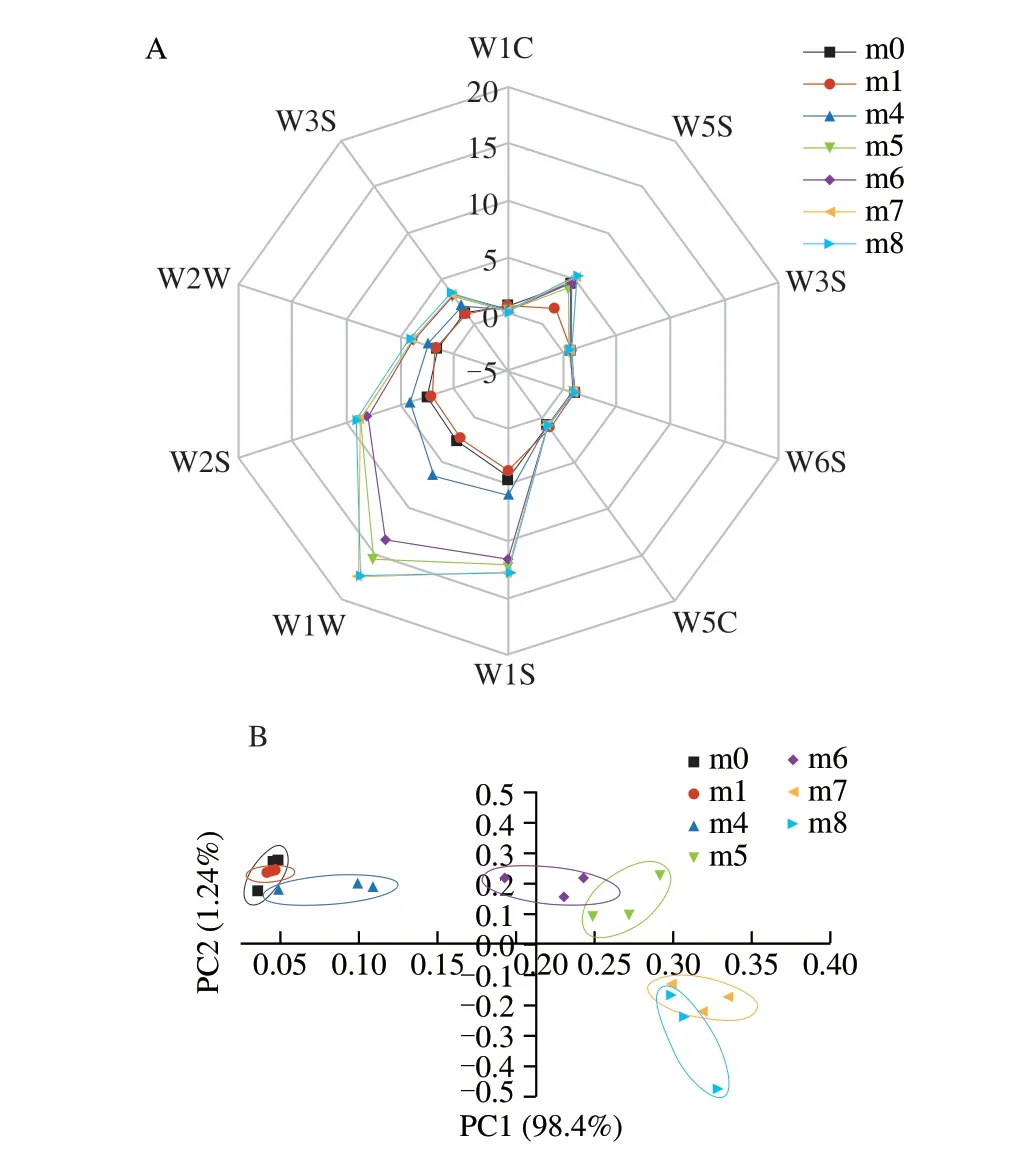
Fig. 1 The volatile compounds in shrimp paste samples at different fermentation periods based on electronic nose data. (A) Radar chart; (B) PCA scores.
3.2 SPME-GC–MS analysis
3.2.1 Identification of volatile compounds in shrimp paste fermentation by SPME-GC-MS
SPME-GC-MS was used to analyze volatile flavor compounds in shrimp paste samples at different fermentation stages (Table 3).A total of 75 volatile flavor compounds were identified in samples at different fermentation stages, including 21 alcohols, 11 ketones,8 esters, 1 acid, 4 hydrocarbons, 2 sulfides, 3 amines, 9 pyrazines,4 aldehydes and 12 other compounds. From the stacked graph(Fig. 2A), it can be seen intuitively that the types of volatile compounds in different shrimp paste samples have changed significantly as the fermentation progressed. Generally speaking, the composition of volatile compounds in the early stage of fermentation was relatively similar. The flavor composition of samples at the fourth month of fermentation had changed, and the difference of volatile compounds in the later stage of fermentation was smaller. This was consistent with the PCA result of the E-nose. Alcohols and amines played a major role in the total amount of volatile compounds in all samples. Aldehydes and pyrazines began to be produced in the fifth month of fermentation.
The changes of a specific volatile compound could be seen by the heat map (Fig. 2B). In this study, alcohol was one of the main volatile flavor compounds. Among them, the unsaturated alcohol had a lower threshold, which was the main substance that gives the shrimp paste meat aroma, mushroom flavor and mild oil flavor [20]. Alcohols are known to be secondary products generated by lipid oxidation [21],and mainly derived from the oxidative degradation of polyunsaturated fatty acids [22]. Ethanol was the alcohol with the highest content detected and increased as the fermentation progresses. The content of 2-methylbutanol firstly decreased and then increased slightly at the late stage of fermentation. The content of 1-octen-3-ol was largest in the fourth month of fermentation, and then decreased. 1-nonanol,n-propanol, phenylethyl alcohol, etc. began to be produced in the middle and late stages of fermentation.
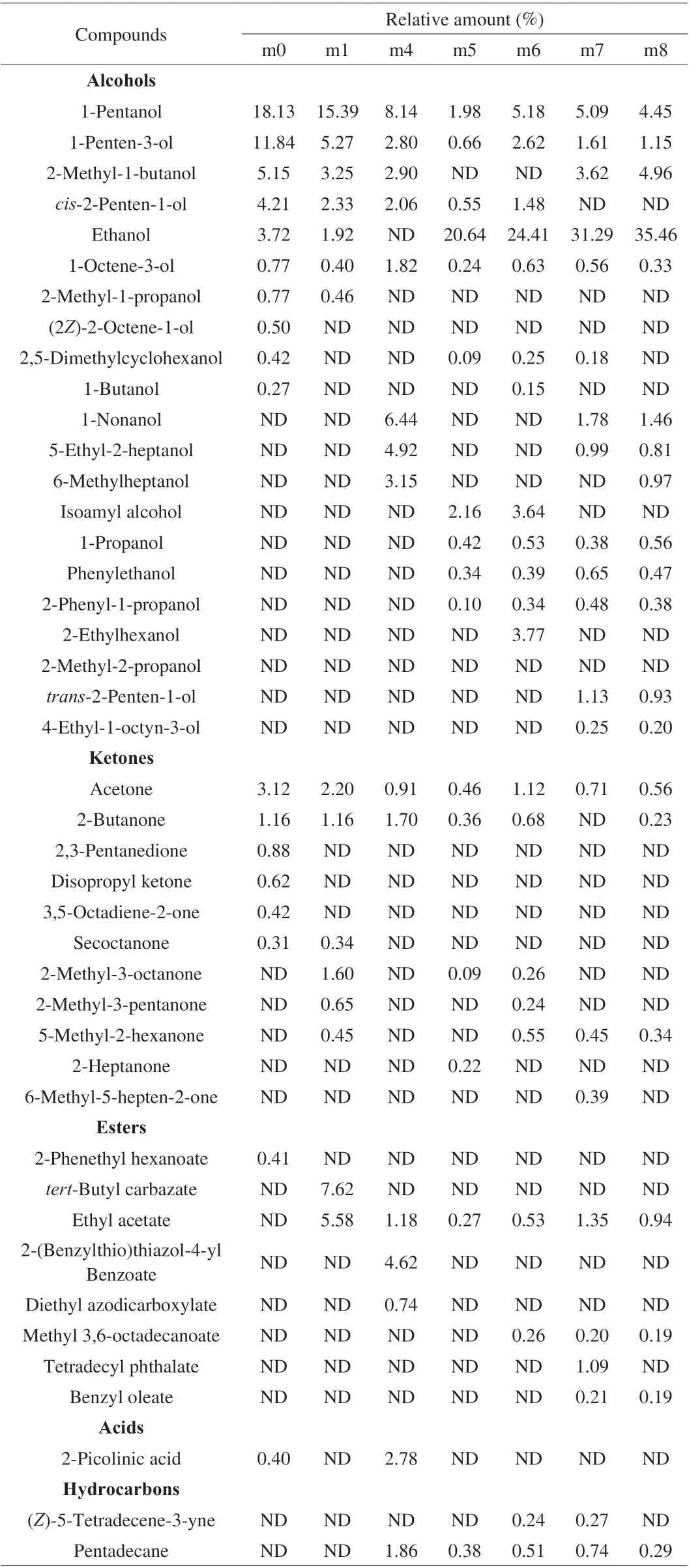
Table 3 Volatile compounds in shrimp paste detected by gas chromatography-mass spectrometry.
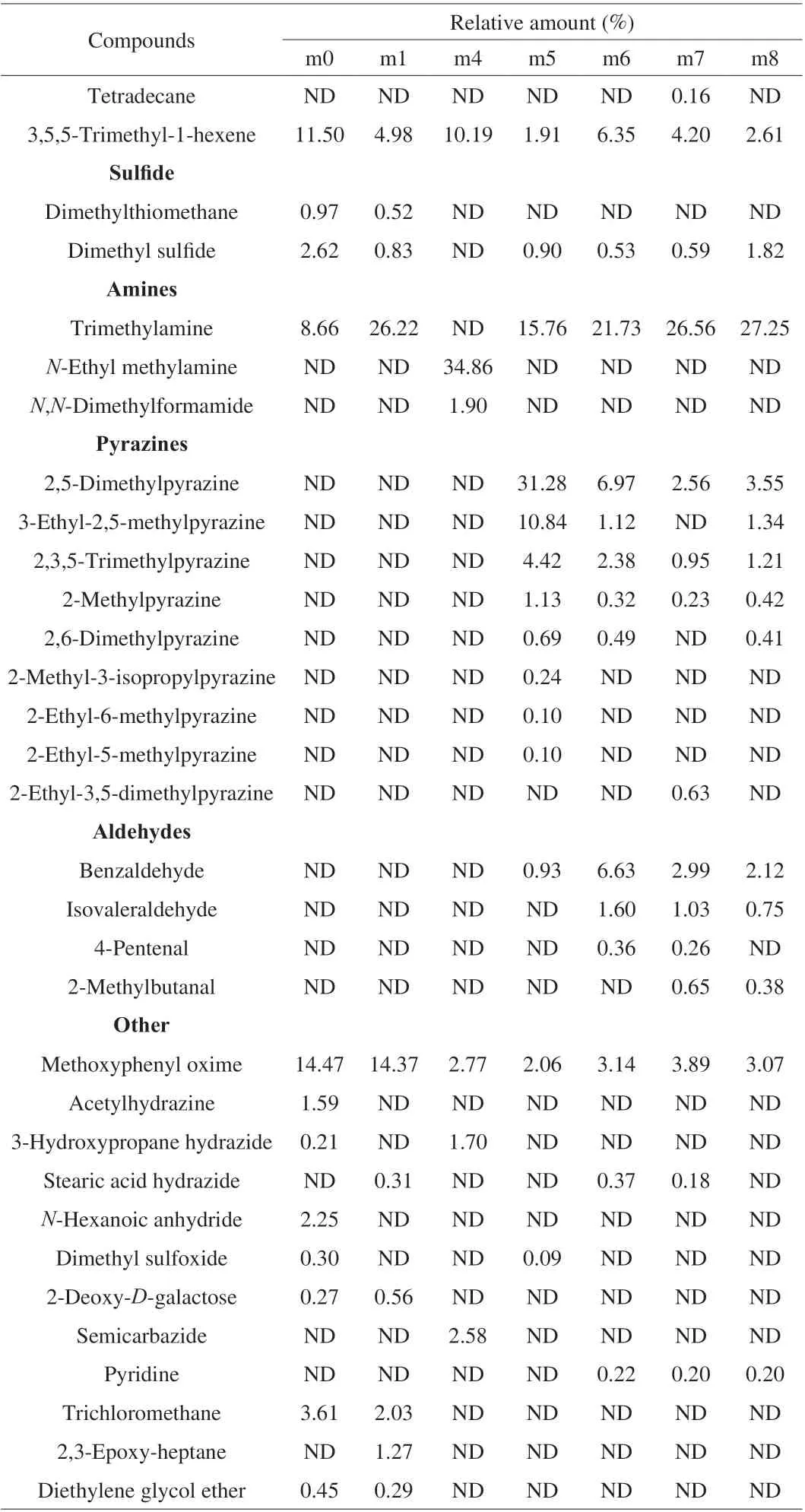
Table 3 (Continued)
Ketones in shrimp paste were produced by the oxidation or degradation of unsaturated fatty acids and amino acid degradation.They usually exhibit floral and fruity aromas and were responsible for the formation of the cheese-like aroma in fish sauce [23]. However,due to its high aroma threshold, they usually enhanced the flavor of the product.
Esters were formed by low-level saturated fatty acids and saturated fatty alcohols and derived from the esterification of alcohols by acids, mainly include ethyl esters. They were produced during the fermentation of shrimp paste and have a low threshold. Most esters have fruity and floral flavors [24]. The flavor of the ester can weaken the pungent taste of fatty acids and the bitter taste of amino groups [25]. Consistent with previous studies, the ethyl acetate content was the highest during the fermentation [26].
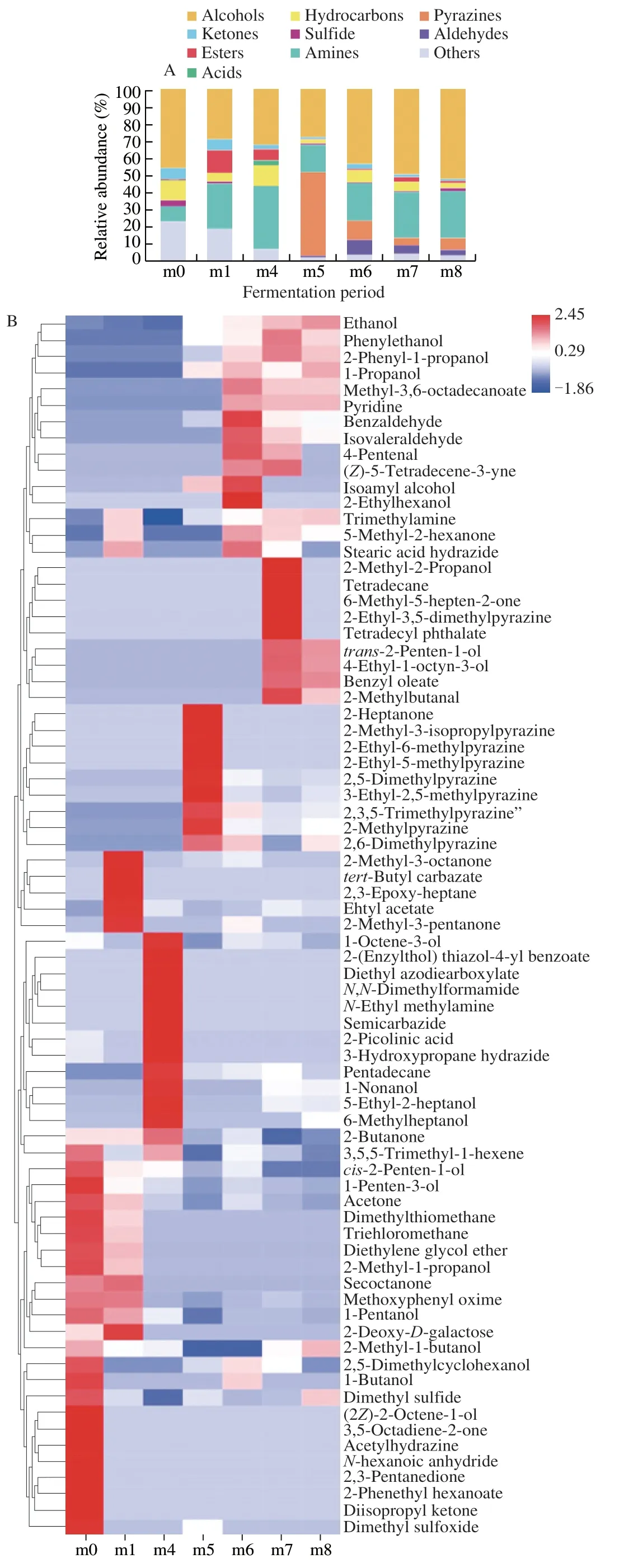
Fig. 2 The volatile compounds in shrimp paste samples at different fermentation periods based on GC-MS data. (A) Stacked graph; (B) Heatmap visualization.
Hydrocarbons may be derived from the oxidation and degradation of fatty acids, which generally have a fragrant and sweet flavor,but the higher threshold results in a little contribution to the overall flavor [27,28]. In general, the content of hydrocarbons gradually decreased with the progress of fermentation. Alkanes are widely present in the volatile components of aquatic products such as crustaceans and fish meat. Some studies believed that they were important intermediates for the formation of heterocyclic compounds that contribute to the flavor of meat, and have a non-negligible base effect on the formation of meat flavor [29]. Olefins can form aldehydes and ketones under certain conditions, which are potential factors for the fishy smell of shrimp paste [30].
Some research reported that the sulfur compounds, such as dimethyl disulfide, dimethyl sulfide, and dimethyl trisulfide act as aroma components and precursors in reactions producing more complex aroma compounds [31,32]. Trimethylamine is a common volatile substance in aquatic products and was the main amine compounds in the fermentation process of shrimp paste. It usually affected the overall fishy smell of the product [33]. Trimethylamine was less in the early stage of fermentation, but increased with the progress of fermentation, which was produced by the reduction of trimethylamine-oxide by facultative anaerobic bacteria [34].
Both aldehydes and pyrazines began to be produced in the middle and late stages of fermentation, and their production had an important contribution to the formation of the flavor of shrimp paste due to their low threshold. Aldehydes were produced in the middle and late stages of fermentation, and then slightly decreased at the end of fermentation, which were the degradation products of lipid oxidation and related to yeast metabolites during fermentation. They played a major role in improving the flavor of shrimp sauces and usually have a pleasant smell similar to grass, malt, fruit and cheese [22,35].Pyrazines are an important compound responsible for the food flavor, which possess a unique organoleptic characteristic that can dramatically influence the sensory aspects of food [36]. They have a great contribution to the formation of shrimp paste flavor due to their low flavor threshold, mainly showing meaty, nutty and roasting aroma like roasted potatoes. Pyrazines were produced in the middle and late stages of fermentation, the content was highest at the m5 stage,and then decreased, which were products of fat oxidation products participating in Maillard reaction [21,37,38].
Some other compounds produced during the fermentation may also contributed to the formation of flavor. Pyridine was produced in the late stage of fermentation. The aldehydes and ketones required to form pyridine were produced during lipid oxidation, therefore the formation of pyridine seems to be another result of the lipid oxidation pathway [39]. Pyridines have low threshold values but diverse flavors.High concentrations of pyridines show an unpleasant irritating taste like the fishy smell, while low concentrations have pleasant aroma characteristics like toast, corn and biscuits [40]. The content of methoxyphenyl oxime was high in the early stage of fermentation,then decreased and remained stable with the fermentation of shrimp paste. At present, there are few studies on its flavor, and it was also detected in some meats.
3.2.2 Screen the key volatile flavor compounds from the volatile compounds in shrimp paste identified by GC-MS
The relative content of the volatile compounds cannot reflect their true contribution to the overall aroma characteristics. Therefore,ROAV was used to detect the contribution of volatile compounds on the overall aroma profile [41]. The greater the ROAV, the greater the contribution of the compound to the overall flavor. The substance with ROAV ≥ 1 is the key flavor compound of the sample, and the substance with 0.1 ≤ ROAV < 1 is the compound that modifies the overall flavor of the sample.
The ROAV and sensory description of volatile flavor components in shrimp paste are shown in Table 4. The ROAV of volatile substances with a low odor threshold and a relatively high content was defined as 100. In the period of m0, m1, the ROAV of trimethylamine,which had a greater contribution to the overall flavor, was set to 100,and those of the other volatile flavor components were calculated in comparison with trimethylamine. A total of 4 volatile components with 0 ≤ ROAV < 1 were identified in the shrimp paste fermentation process by SPME-GC-MS, including 1-pentanol, 1-penton-3-ol,(2Z)-2-octene-1-ol, and benzaldehyde, which contributed to the overall flavor. Thirteen volatile components with ROAV ≥ 1, of which 9 were the key volatile components in the middle and late fermentation stages, namely 1-octen-3-ol, isobutanol, 1-nonanol,isoamyl alcohol, ethyl acetate, dimethylthiomethane, dimethyl sulfide, trimethylamine, 3-ethyl-2,5-methyl pyrazine, 2,3,5-trimethyl pyrazine, 2-methyl-3-isopropyl pyrazine, isovaleraldehyde and 2-methyl butanal. 1-octen-3-ol was the oxidation product of linoleic acid, which has a mushroom and earthy smell [42]. Its content was very high in fresh shrimp paste, then gradually decreased and reached the minimum in the m5 period, later raised and remained relatively stable in the later stage of fermentation. Iglesias et al. proved that the content of 1-octen-3-ol is highly correlated with the value of fish fat oxidation index thiobarbituric acid (TBARS), which can reflect the level of fish fat oxidation to a certain extent [43]. Branched-chain alcohol, isobutanol was usually produced by the glycolysis pathway of carbohydrates (Embden-Meyerhof-Parnas, EMP) and the Ehrlich pathway of amino acids [44]. It has a wine taste and only existed in early stage of the fermentation of shrimp paste. 1-Nonanol was a volatile substance that contributed to the overall flavor in the late stage of fermentation, which is an important volatile flavor substance in a variety of meats with an aroma similar to fat, rose and citrus [45].Isoamyl alcohol only appeared in the two periods of m5 and m6,and disappeared in the fermentation maturity period. Some research proved that it is mainly produced fromα-ketoisocaproate in the pathway of l -leucine biosynthesis, which is regulated by endproduct inhibition ofα-isopropyl malate synthase (IPMS) [46]. It has a wine and fruity aroma such as bananas and is often detected in wine and bread.
Ethyl acetate was produced in the m1 period, and then the content gradually decreased with the progress of the fermentation,and reached the lowest point in the m5 period, finally its content raised and stabilized in the last two months of fermentation. Ethyl acetate is commonly found in fermented products and contributed a fruity aroma to the overall flavor [5]. Dimethylthiomethane only existed in the early stage of fermentation, with onion and mushroom flavor. The content of dimethyl sulfide showed a decreasing trend as the fermentation progressed, but the content rises sharply during the m8 period. Some studies believed that it is the product of degradation of cysteine and methionine by microorganisms or endogenous enzymes [29]. Dimethyl sulfide is considered tobe the most important volatile sulfide in the ocean which has a fragrance similar to fish and crab meat at low concentrations [47].Trimethylamine is usually regarded as a reduction product of trimethylamine oxide and is known to widely exist in seafood products, which is one of the main sources of a fishy odor [48], but there are also studies suggest that trimethylamine is a contributing factor to the aroma of crustaceans after cooking [29].
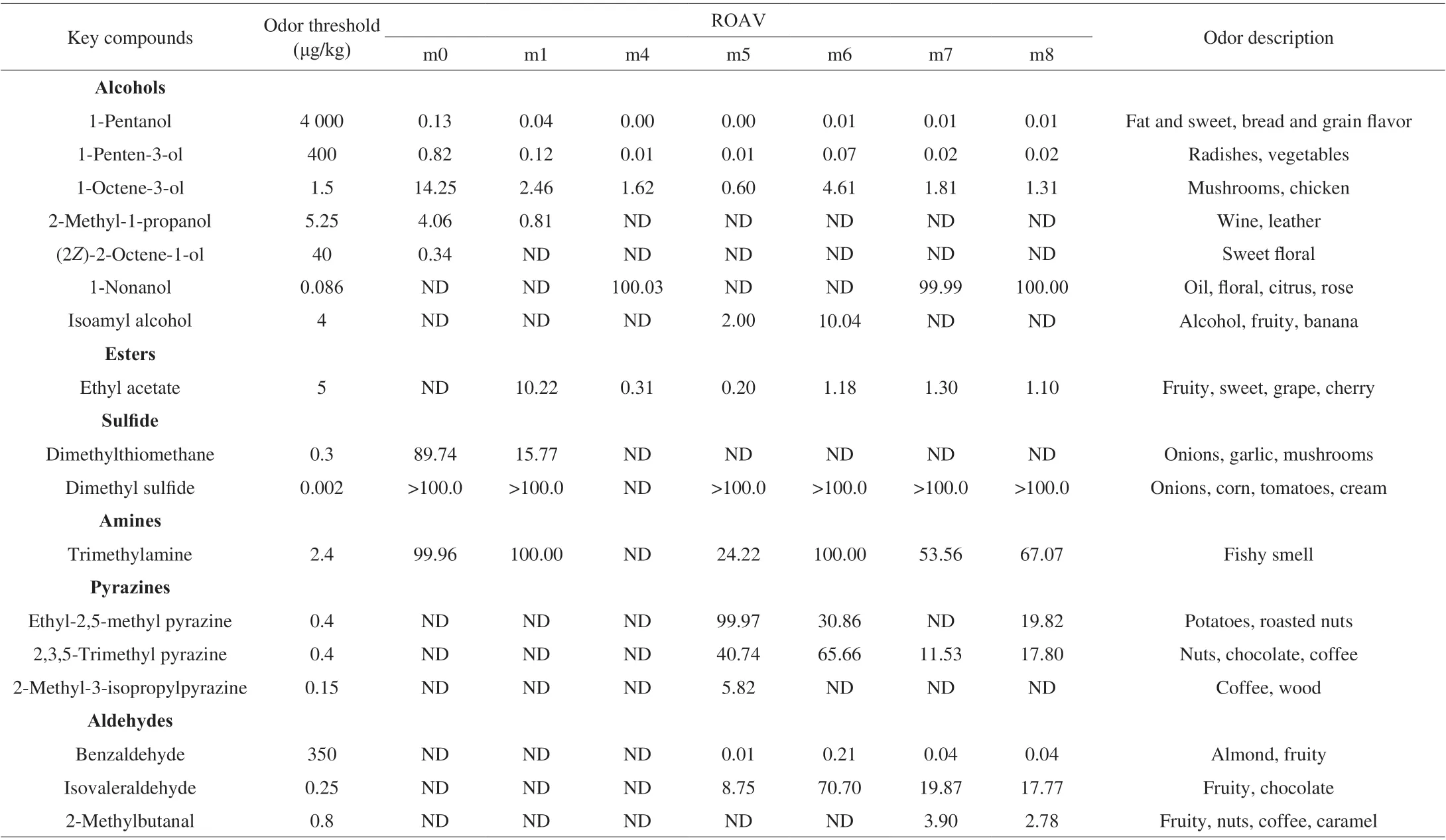
Table 4 Key volatile compounds in shrimp paste detected by gas chromatography-mass spectrometry.
The volatile components that contributed significantly to the aroma of shrimp paste were all produced in the middle and late stages of fermentation. Both 3-ethyl-2,5-methyl pyrazine and 2,3,5-trimethyl pyrazine decreased in the last two months of fermentation which gave the product a nutty flavor [49]. Isovaleraldehyde was a metabolite of polyunsaturated fatty acids, with the smell of fruit and chocolate. Its content reached its maximum in the m6 period and then decreased to a stable level. 2-Methylbutanal only existed in the last two months of fermentation and was formed by the Strecker degradation reaction of isoleucine [50]. It contributed nutty and fruity aromas to the overall aroma.
3.3 HS-GC-IMS analysis
3.3.1 Identification of volatile compounds in shrimp paste fermentation by HS-GC-IMS
HS-GC-IMS was used to analyze the volatile organic components(VOCs) of shrimp paste with different fermentation periods(Fig. 3A). It could be seen that as the fermentation progressed, the volatile components in the shrimp paste were gradually enriched with the extension of the fermentation time, and the types and contents occurred significant changes. In order to clarify which substances have changed, all peaks were selected for fingerprint comparison(Fig. 3B). Each row represents a sample and each column represents a compound. Known compounds were marked with existing names and unknown compounds were marked with numbers. A total of 63 signal peaks were detected in the shrimp paste samples at all fermentation stages, and 31 typical VOCs (including monomers and dimers) were identified. However, due to the limited data in the library database,there were still 32 compounds without qualitative results. Therefore,HS-GC-IMS is more suitable for using as a visualized analysis method to monitor the changes in flavor quality during the fermentation of shrimp paste. According to the HS-GC-IMS identification results, the VOCs in shrimp paste at different fermentation stages mainly include alcohols, ketones, esters, aldehydes, and heteroatoms (pyrazines and thioethers). The VOCs that have a great impact on the flavor of shrimp paste were mainly produced in the middle and late stages of fermentation. The overall trend of changes in volatile components were consistent with the results of GC-MS. The substances in the red box in Fig. 3B, such as 3-methylbutanal, 2-methylbutanal and butanone, increased significantly when the shrimp paste was fermented to the m4 stage, and then gradually decreased. The substances in the green box, such as 2,5-dimethylpyrazine, ethyl isovalerate, ethyl acetate, and propionaldehyde, increased significantly at the m5 stage, and then gradually decreased. In the yellow box,the substances such as ethyl caproate, 1-pentanol, heptaldehyde,isobutyraldehyde and 1-butanol, etc., showed an overall downward trend with the fermentation progressed of shrimp paste, and the 2-pentanone was the highest in the m4 stage then decreased.
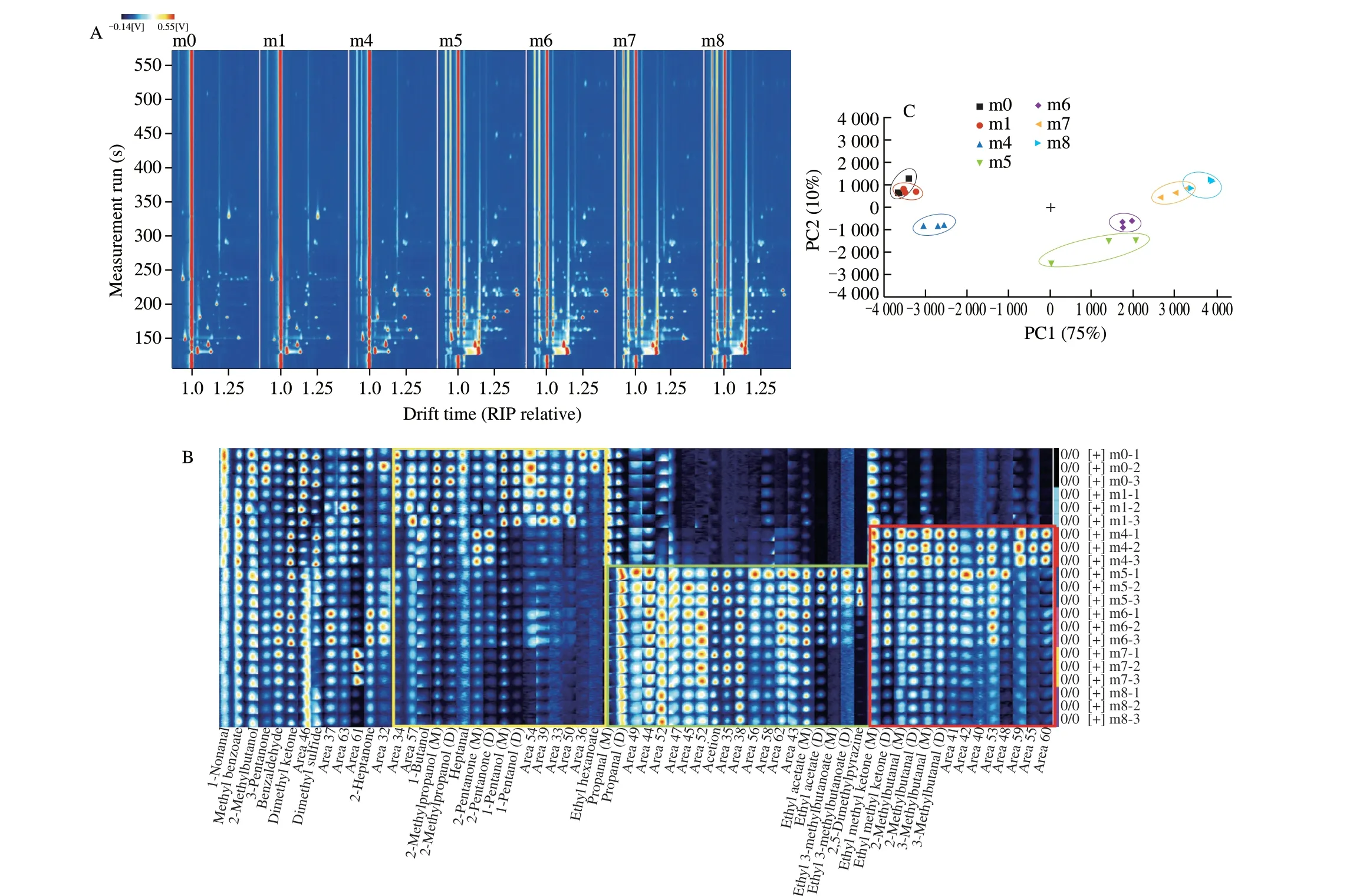
Fig. 3 The volatile compounds in shrimp paste samples at different fermentation periods based on GC-IMS data. (A) GC-IMS spectra; (B) Gallery plot(fingerprint); (C) PCA diagram.
PCA was used to reduce its dimensions and to use the classifying procedure in a smaller sub-feature space to illustrate the correlations between the shrimp samples with different fermentation stages(Fig. 3C) [51]. The PCA results could distinguish samples from different periods [52], which showed that the similarity between m0 and m1 samples was high, m5 and m6 samples were similar, m7 was similar to m8. However, m4 was different from other periods.It may be due to the significant increase in the ambient temperature during the m4 period that caused dramatic changes in the composition and activity of the bacterial community, which ultimately led to the formation of a large number of volatile metabolites. These results consistent with the E-nose and SPME-GC-MS.
3.3.2 Screen the key volatile flavor compounds from the volatile compounds in shrimp paste identified by HS-GC-IMS
The method of ROAV was also used to screen the key volatile compounds in the VOCs identified by HS-GC-IMS. A total of 3 VOCs with 0 ≤ ROAV < 1 and 8 VOCs with ROAV ≥ 1 were identified by the HS-GC-IMS. The high sensitivity of HS-GC-IMS technology can make up for SPME-GC-MS’s inability to detect trace substances.In addition to ethyl acetate, dimethyl sulfide, 2-methylbutyraldehyde,and isovaleraldehyde that have been identified by SPME-GC-MS,nonanal, ethyl caproate, ethyl isovalerate, and propionaldehyde have also been identified as key volatile flavor compounds. Nonanal was higher in the early stage of fermentation, and then gradually decreased. Furthermore, it was stable in the late period. It was produced by the oxidation of unsaturated fatty acids and has a flavor similar to grass, citrus, fat and earthy [53]. Ethyl caproate is a common volatile substance in alcoholic beverages that has a fruity and wine aroma. It was the highest in fresh shrimp paste then decreased dramatically after the fermentation started. Ethyl isovalerate contributed fruit flavor to the overall flavor, and its content reached the maximum value in the middle of fermentation and then gradually decreased.Propionaldehyde showed an overall upward trend during the fermentation process, with a slightly pungent fruit smell.
4. Conclusion
Seventeen key volatile aroma components in shrimp paste were identified at different fermentation stages. The combination of the E-nose, SPME-GC-MS and HS-GC-IMS technology could make up for their respective limitations, more comprehensively reflected the changes of volatile components. The high efficiency and sensitivity of HS-GC-IMS offered the possibility of using it as a visualized tool for monitoring the flavor change. During the research, it was found that most of the production of flavor substances was related to the degradation and metabolism of flavor precursors, such as amino acids and fatty acids. Since the fermentation process was closely related to the biochemical metabolic pathways of various microorganisms and enzymes, the correlation between key flavor compounds, enzymes and microorganisms will be further explored as the focus of the next research. This is of great significance to flavor quality control and industrialization of shrimp paste production process.
Declaration of competing interest
The authors state that there is no conflict of interest in this paper.
Acknowledgements
This project had support from the National Key R&D Program of China (2019YFD0901903) and the Innovation Team Project of Hebei (Province) Modern Agricultural Industry Technology System(HBCT2018170207), and the Postgraduate Research & Practice Innovation Program of Jiangsu Province (SJCX20_1426).
杂志排行
食品科学与人类健康(英文)的其它文章
- Evaluation and selection of yeasts as potential aroma enhancers for the production of dry-cured ham
- Preserved egg white alleviates DSS-induced colitis in mice through the reduction of oxidative stress, modulation of inf lammatory cytokines,NF-κB, MAPK and gut microbiota composition
- Energy status regulated umami compound metabolism in harvested shiitake mushrooms (Lentinus edodes) with spores triggered to release
- Edible mushrooms as a potent therapeutics of subclinical thyroid dysfunction among adults, especially in obese individuals: a prospective cohort study
- Screening hepatoprotective effective components of Lonicerae japonica Flos based on the spectrum-effect relationship and its mechanism exploring
- Effects of the degree of oral processing on the properties of saliva-participating emulsions: using stewed pork with brown sauce as the model
